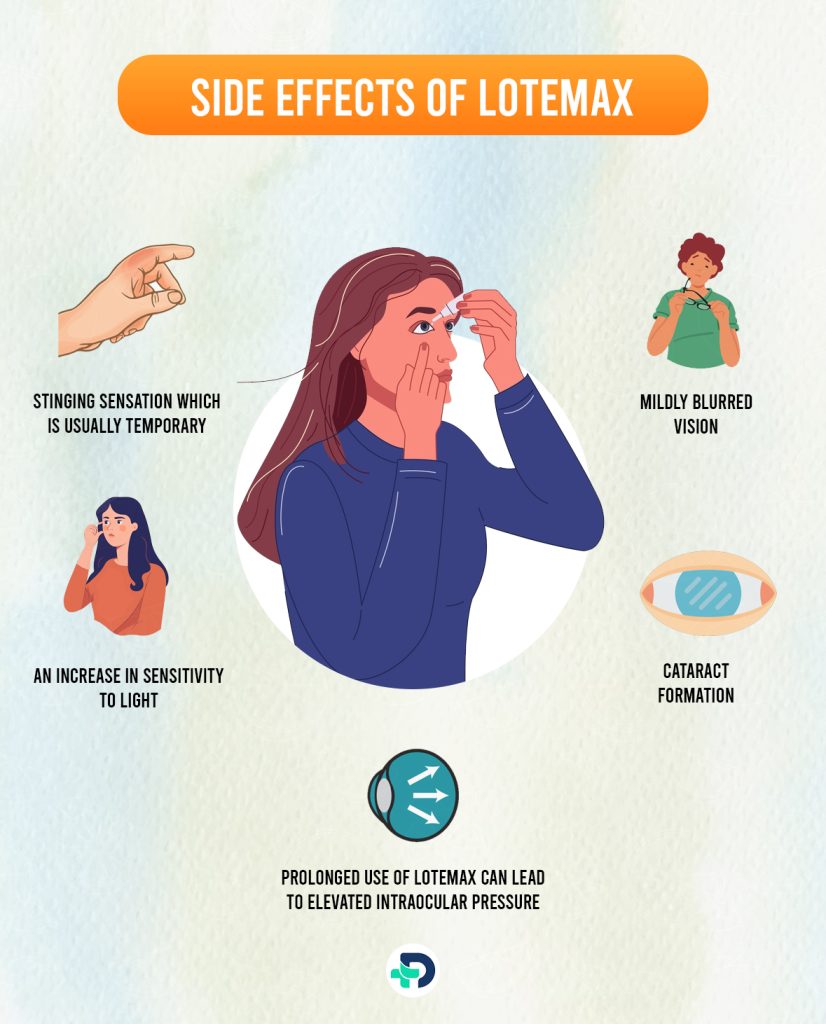Lotemax: A Comprehensive Guide to Uses, Benefits, and Side Effects

- Lotemax
- 06 Sep 2023
Introduction
What is Lotemax?
In the realm of pharmaceuticals, Lotemax stands out as a versatile and effective medication. Used to treat a range of eye conditions, this medication has gained popularity due to its potential benefits and relatively manageable side effects. Lotemax is a corticosteroid, which are a class of drug that play a vital role in alleviating inflammation and providing relief to various eye ailments.This article provides a simplified overview of Lotemax, including its pharmacology, mechanism of action, different uses, dosage, potential side effects, and frequently asked questions.1Introduction | Researched based study from National Institutes of Health

Mechanism of Action
How does Lotemax work?
- Class of Drug: Corticosteroids
- Corticosteroids are a type of drug which are synthetic analogue of hormones, produced by the body’s adrenal glands.1Mechanism of Action | Researched based study from National Institutes of Health
- They are very widely used in order to reduce inflammation in various parts of the body, which includes the eyes.
- These drugs work by the mechanism of inhibition of production of certain chemicals that trigger various inflammation processes and therefore help in suppressing the immune response.
- Depending on the condition being treated, these drugs can either be taken via the oral route or be applied locally.
Pharmacology
Pharmacology of Lotemax
Delving further into the pharmacology of Lotemax, it’s important to understand how this medication exerts its effects on the eye tissues.
- Lotemax contains the active ingredient loteprednol etabonate, which is a corticosteroid specifically formulated for ophthalmic use.
- It is hence a highly valuable tool in managing various eye related conditions, due to its unique properties.
Selective Local Action:
- One of the distinguishing features of Lotemax is its selective action.
- Loteprednol etabonate is designed to undergo rapid metabolism in the eye tissues, which limits its systemic absorption.
- This characteristic minimizes the potential for systemic side effects that are often associated with systemic corticosteroids.
- Instead of circulating throughout the body, Lotemax remains largely within the ocular tissues, where it exerts its anti-inflammatory effects.
Reduced Intraocular Pressure:
- Elevated intraocular pressure (IOP) is a concern with some corticosteroid medications, as it can contribute to conditions like glaucoma.
- However, Lotemax has been shown to have a lower propensity to cause such increases in IOP.
- This is particularly advantageous when treating conditions like uveitis, where corticosteroids are essential for managing inflammation but need to be used with caution due to the potential for increased pressure within the eye.
Dual Action: Anti-Inflammatory and Immune Modulation:
- Lotemax operates through a dual mechanism. Firstly, it is highly efficient in order to curb inflammation by inhibiting the production of inflammatory mediators such as cytokines and prostaglandins.
- By reducing the levels of these mediators, Lotemax helps suppress the cascade of events that lead to inflammation, thereby mitigating symptoms like redness, swelling, and discomfort.
- Secondly, Lotemax has immune-modulating properties. It can influence the immune response within the eye, helping to regulate the immune cells responsible for inflammation.
- This dual action makes Lotemax a potent tool in managing conditions where inflammation and immune response are intricately linked.
Formulations
Lotemax is available in two main formulations:
- Eye drops
- Ointment
Therefore, the preferred choice of a specific formulation depends not only on the condition being treated but also the patient’s preferences.
Eye drops are highly convenient as they allow for easy application of the drops directly onto the affected areas.
On the other hand, ointments provide a longer contact time with the eye tissues, making them suitable for conditions requiring sustained relief.
Uses
Different Uses of Lotemax
Lotemax is also used to treat following conditions: 2Uses | Researched based study from National Institutes of Health
- Allergic Conjunctivitis
- Postoperative Inflammation
- Uveitis
- Keratitis
- Iritis
- Conjunctivitis
- Other Ocular Inflammatory Conditions
Allergic Conjunctivitis: Soothing Irritated Eyes
- Allergic conjunctivitis is a highly common condition which is characterized by feeling of an itchy sensation along with redness and watering in eyes due to an allergic reaction.
- Lotemax’s anti-inflammatory prowess proves invaluable in managing these symptoms.
- By curbing the production of inflammatory molecules like prostaglandins and cytokines, Lotemax alleviates discomfort, reduces redness, and restores visual comfort to individuals plagued by allergic reactions.
Postoperative Inflammation: Nurturing Healing Eyes
- After eye surgeries, inflammation is an expected response. Lotemax steps in as a trusted ally in this scenario, helping to manage postoperative inflammation and promoting healing.
- By suppressing inflammation, Lotemax prevents excessive discomfort, redness, and swelling, allowing the eye to recover more swiftly and effectively.
Uveitis: Balancing the Immune Response
- Uveitis, an inflammation of the middle layer of the eye, can lead to severe discomfort and even vision loss if left untreated.
- Lotemax’s dual action mechanism becomes crucial here. It suppresses the production of inflammatory cytokines and, simultaneously, modulates the immune response within the eye.
- This combination helps control inflammation while preventing an overactive immune reaction that could worsen the condition.
- Lotemax thus plays a pivotal role in managing uveitis, ensuring relief and preservation of visual health.
Keratitis: Combating Infections and Irritants
- Keratitis, inflammation of the cornea, can result from infections or exposure to irritants. Lotemax proves its mettle by reducing discomfort and inflammation associated with keratitis.
- Its ability to mitigate the effects of inflammatory molecules helps alleviate the sensation of foreign body presence, redness, and the urge to rub the eyes, which could exacerbate the condition.
Iritis: Easing Painful Inflammation
- Iritis, characterized by inflammation of the iris, can be excruciatingly painful and lead to sensitivity to light. Lotemax comes to the rescue by not only reducing pain but also managing inflammation.
- By inhibiting the production of inflammatory mediators, Lotemax provides much-needed relief to individuals suffering from iritis.
Conjunctivitis (Pink Eye): Quelling Irritation
- Conjunctivitis, commonly known as pink eye, involves inflammation of the conjunctiva—a thin, transparent layer covering the white part of the eye.
- Lotemax’s anti-inflammatory properties prove beneficial here as well. By alleviating redness, swelling, and discomfort, Lotemax offers a soothing touch to individuals grappling with conjunctivitis.
Other Ocular Inflammatory Conditions: A Versatile Asset
- Beyond the highlighted conditions, Lotemax’s applications extend to various ocular inflammatory conditions.
- It serves as a reliable intervention in cases where inflammation threatens visual comfort and health.
- Its localized action and minimized systemic effects make it an ideal choice for conditions where precision is paramount.
Side Effects

Side Effects
While Lotemax is generally well-tolerated, there are potential side effects to be aware of Common side effects include: 3Side Effects | Researched based study from Bausch Health companies Inc
- Stinging sensation which is usually temporary
- Mildly blurred vision
- An increase in sensitivity to light
- In rare cases, prolonged use of Lotemax can lead to elevated intraocular pressure
- Cataract formation.
It’s important to follow the prescribed dosage and inform your healthcare provider if you experience any unusual or persistent side effects.
Precautions
Precautions
Safety is paramount when using any medication. Here are precautions to consider while using Lotemax: 3Precautions | Researched based study from Bausch Health Companies Inc
- Inform Your Healthcare Provider: Always disclose your complete medical history, including current medications, to your healthcare provider. This information helps them make informed decisions about Lotemax’s suitability for your situation.
- Follow Dosage Instructions: Strictly adhere to the prescribed dosage and frequency of Lotemax as directed by your healthcare provider. Altering the dosage without medical advice may lead to adverse effects.
- Regular Eye Examinations: Regular eye check-ups are crucial while using Lotemax, especially if the duration of treatment is prolonged. These examinations help monitor your ocular health and detect any changes in IOP or other potential side effects.
- Contact Lens Use: If you wear contact lenses, remove them before applying Lotemax. Reinsert your lenses after waiting for about 10 minutes, ensuring the medication is well-absorbed.
- Pregnant or Nursing: If you are pregnant, planning to become pregnant, or nursing, consult your healthcare provider before using Lotemax. The potential benefits and risks must be evaluated in these situations.
Dosage
Dosage
- The recommended dosage of Lotemax is variable and depends on the specific condition which is being treated.
- Generally, one to two drops of the eye suspension should be applied to the affected eye(s) two to four times daily.
- Based on the response to the medication, the healthcare provider can adjust your dosage for the drug.
Storage
Storage
- Keep the drug out of reach of children. Make sure it is stored in an airtight, upright container.
- Do not use the drug if it is more than 28 days after opening the bottle. Also discard drug if it is past its expiration date. Do not freeze the drug. 4Storage | Researched based study from Electronic Medicines Compendium
FAQ’s
FAQs about Lotemax
Q1: Can Lotemax be used for viral eye infections?
No, Lotemax is a corticosteroid and is not effective against viral infections. It is best suited for managing inflammation caused by allergic reactions, irritants, or certain inflammatory conditions.
Q2: Can I wear contact lenses while using Lotemax?
Always remove your contact lenses before applying Lotemax. You can reinsert them about 10 minutes after using the medication.
Q3: Can Lotemax be used during pregnancy?
It’s advisable to consult your healthcare provider before using Lotemax during pregnancy, as the potential risks and benefits need to be assessed.
Conclusion
Conclusion
Lotemax, a corticosteroid ophthalmic medication, offers relief to individuals suffering from a range of eye conditions. Its ability to curb inflammation and alleviate discomfort makes it a valuable tool in ophthalmology. However as with any sort of medication, it’s highly crucial to follow your healthcare provider’s instructions and to share with them, any concerns or side effects on using the drug. The simplicity of its application, coupled with its potential benefits, positions Lotemax as an accessible option for managing eye inflammation and related symptoms.
Any feedback on this article?
 This Articles content was accurate
This Articles content was accurate Very Informative Article
Very Informative Article I have a question or a comment
I have a question or a comment
 This article contains inaccurate content
This article contains inaccurate content This article was not helpful
This article was not helpful I have a question or a comment
I have a question or a comment
We appreciate your helpful feedback!
Checkout our social pages
References
-
National Institutes of Health
Introduction | Mechanism of action
-
National Institutes of Health
Uses
-
Bausch Health Companies Inc
Side Effects | Precautions
-
Electronic Medicines Compendium
Storage






































